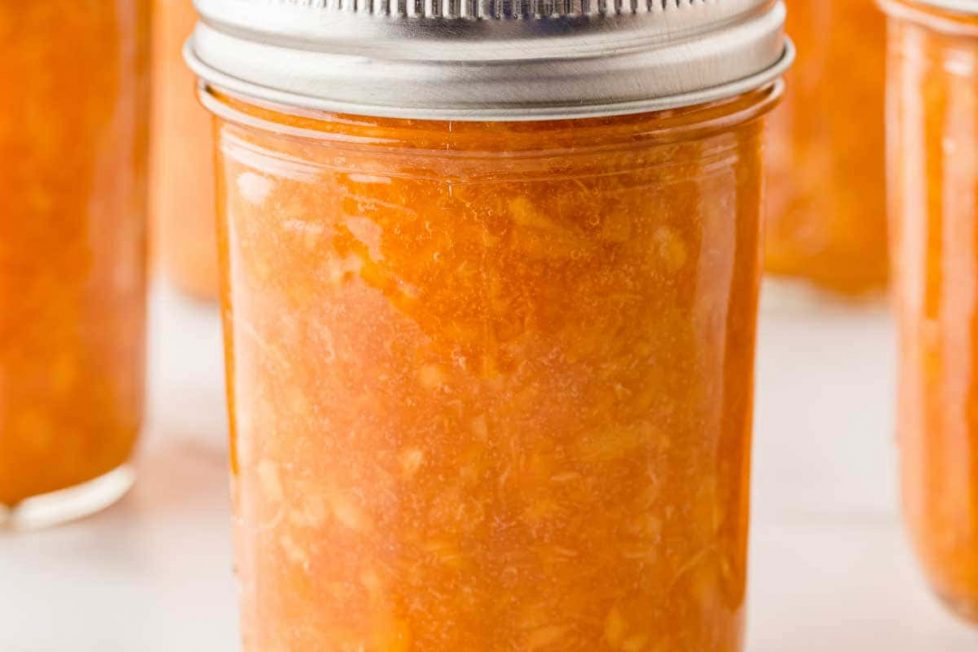Homemade Nectarine Jam Recipe

One thing about grocery store shelves is that they don’t always offer up a huge selection. Case in point: nectarine jam. It’s not readily available commercially, but you can use this sweet summertime fruit to make up a batch of jam for your morning toast!
One of my favorite reasons for canning nectarines is that I don’t have to peel them. That’s true for this thick and gooey jam, too. What a timesaver!
Ready to DIY your pantry with healthier ingredients? Check out my ebook, The Handcrafted Pantry! Filled with delicious recipes for some of your favorite condiments, snacks, and toppings, it’s the guide you need to start skipping packaged products and embrace homemade.
Nectarines – You’ll need 6-7 pounds of ripe nectarines to make this recipe. Use any type of yellow nectarine that you have readily available. A freestone variety will be easier to pit than a cling variety. (Read more about stone fruit.) Do not use white nectarines for this recipe; these fruit are less acidic than the yellow variety and can alter the pH of the recipe making it unsafe for canning.
Sweetener – This recipe calls for using two cups of sugar as the sweetener. If you’d prefer to use honey, use one cup of honey. (Honey is sweeter than sugar, so you can use less. )
Lemon juice: USDA preserving recipes all call for using bottled lemon juice. This assures that the acidity level in recipes is safe for canning.
Pectin – This recipe is made using Pomona’s Universal Pectin. This is the only pectin I use anymore as it allows me to use much less sweetener. The standard pectin brands use an obscene amount of sugar in my opinion, often requiring equal amounts of sugar and fruit! This product uses a low methoxyl method and calls for using two different ingredients, which are included in the box: pectin (the large packet) and calcium powder (the small packet). The dry pectin is mixed with the sweetener before being added to the fruit. The calcium is combined with water and added directly to the fruit.
Ready to switch from store bought to homemade? Let me help you make some changes! Grab my FREE five-part guide to getting started.
Wash and dry the nectarines. Cut roughly into quarters, then mash with a potato masher. Alternatively, you can pulse the fruit in a food processor to make pulpy chopped nectarines.
Measure the mashed nectarines into a large stockpot along with the lemon juice and calcium water.
Combine the pectin with the sugar, making sure it’s thoroughly combined.
When the nectarine mixture reaches a full rolling boil, add the sugar to cooking fruit, stirring for a minute or two to assure that the pectin is well distributed.
This recipe measured at a pH under 3.5, putting it well into the “safe” zone for water bath canning.
Canning is an excellent way to preserve food for the pantry, but there are some important safety considerations to keep in mind. The recipes on this site have been made following safe canning procedures by a certified Master Food Preserver.
You’ll need special canning jars, lids, and rings to make this a shelf-stable product, but the process isn’t difficult.
Transfer hot jam into canning jars, leaving a quarter-inch headspace. Use a non-metallic knife or bubble tool to remove any air bubbles. Wipe the rims of the jars, removing any residue. Place the lids on and process them in a water bath canner. What this means is you’ll put the filled and sealed jars of jam into boiling water and heat them for ten minutes. This assures that the jars will seal well and kills off any potential bacteria in the jam mixture itself.
Hot tip: Boil some extra water in a saucepan or electric kettle as you’re working. If you need to top off the water in the canner, you won’t cool down the water too much.
Use a jar lifter to remove the hot jars to a towel-covered countertop and allow to cool fully. As they cool, you’ll hear the little “tink” sound of the jars sealing. Store any unsealed jars in the fridge and use those first. (This is unusual, but it does happen once in awhile.)
Remove the ring from each sealed jar of peach preserves, rinse to remove any jam residue, and store at room temperature in a dark place such as the pantry. Opened jars should be kept refrigerated; they’ll last in the fridge for several weeks.
Head over here for more information about canning jams and jellies and even more jam recipes to make with summertime fruit!
You don’t have to can this jam. You can transfer it to the refrigerator if you’ll use it within several weeks. Or you can freeze it.
To make nectarine freezer jam, follow the instructions to make the jam. Instead of canning it, transfer jam to freezer containers allowing plenty of room for expansion. (Straight-sided canning jars work well; just allow an inch and a half headspace.)
Do not use white nectarines for this recipe; these are less acidic than the yellow variety and can alter the pH of the recipe making it unsafe for canning.
This recipe is made using Pomona’s Universal Pectin. This is the only pectin I use anymore as it allows me to use much less sweetener. The standard pectin brands use an obscene amount of sugar in my opinion, often requiring equal amounts of sugar and fruit! This product uses a low methoxyl method and calls for using two different ingredients, which are included in the box: pectin (the large packet) and calcium powder (the small packet). The dry pectin is mixed with the sweetener before being added to the fruit. The calcium is combined with water and added directly to the fruit.
Click to save or share!
